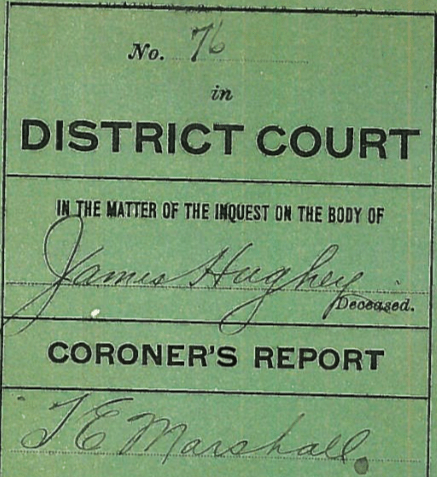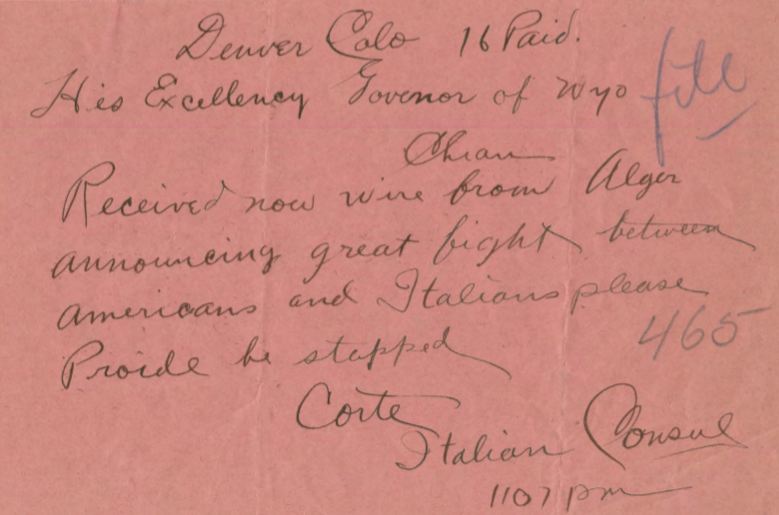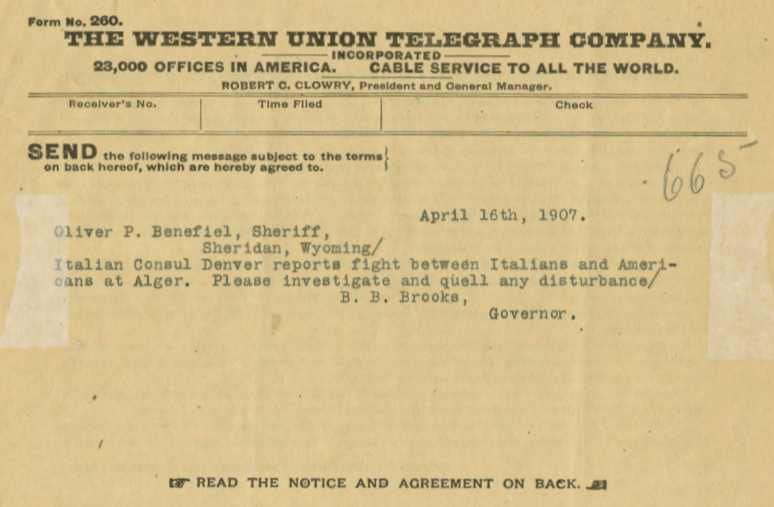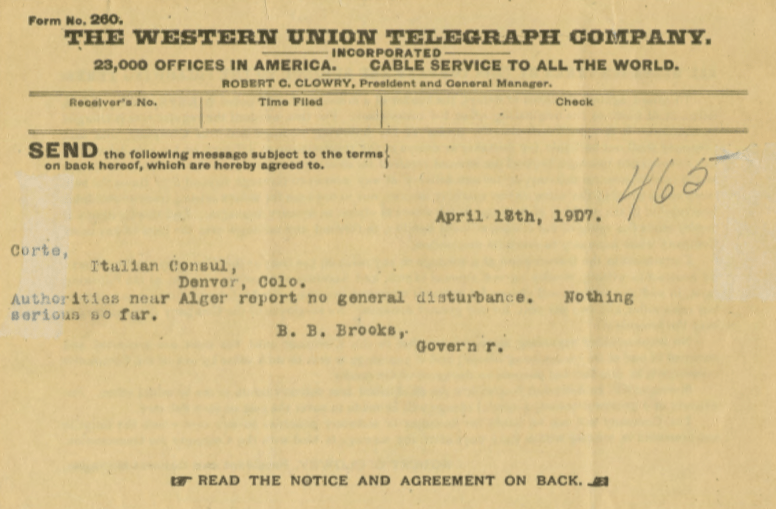My previous posts discussed the fight that erupted between Italian and American miners in the Carneyville coal-camp seven miles from the town of Sheridan, Wyoming. There was one man killed, James Hughey; Charles Fuller was severely injured; and Dan Reynolds was beaten.

No.76 in District Court in the Matter of the Inquest on the Body of James Hughey, Deceased, Coroner’s Report,” 17 April 1907
No arrests could be made for the murder of James Hughey. According to the Coroner’s report filed by Dr. T.E. Marshall, to Sheridan County Clerk, L.B. Glafcke on 17 April 1907, the day after Hughey died, Marshall confirmed Hughey’s death was from a 5.5 inch length cut with a stiletto or “dirk” knife. The autopsy showed the beginning of peritonitis, or infection, which, the doctor stated, “had the victim not died of internal bleeding in all probability peritonitis would have carried him off.”[1]
As mentioned in the previous post, the Italian Consul Giuseppe Corte, traveled by train from Denver, Colorado to Cheyenne, Wyoming to meet with Governor Brooks Bryant, but this did not happen until 28 April, which was two weeks after the event.
The record shows that Corte was worried about the incident. According to Governor Bryant’s records at the Wyoming State Archives, Corte was notified by a telegram on the evening of the affray and drafted a telegram to Governor Bryant at 11:07 pm the evening of 14 April.[2] The wire was sent to the Governor the next morning, 15 April, at 9:37 a.m. The telegram began, “His Excellency, Governor of Wyoming, received now wire from Alger [another name for Carneyville], announcing a great fight between Americans and Italians. Please proide [? provide] be stopped. Corte, Italian Consul.[3]

[Giuseppe] Corte, Italian Consul, Denver, Colorado, to Excellency Governor of Wyoming, handwritten note for telegram, [14 April 1907]

Bryant B. Brooks, Governor, Cheyenne, Wyoming, Oliver B. Benefiel, Sheriff, Sheridan County, 16 April 1907
On Wednesday, 17 April, Governor Bryant personally responded to Consul Corte, “Authorities near Alger report no general disturbance, nothing serious so far.”[5]

Bryant B. Brooks, Governor, Cheyenne, Wyoming, Italian Consul Giuseppe Corte, Denver, Colorado, 17 April 1907, “ No general disturbance”
By 18 April Hughey was dead and the newspapers had found the coroner’s report. News articles were written to sensationalize the murder using inflammatory language, such as, “dastardly murder;” “disemboweled,” and “nineteen stitches used to sew him up,” to describe Hughey’s injuries. These words were not in the report, but it is possible the witnesses at the inquest provided interviews to the reporters.
Several news accounts also described the Carneyville community as upset and on the verge of a“riot,” and there were “high tensions.” There were no subsequent reports of an outbreak of violence that were found in the newspaper literature.
More newspaper articles revealed there were actually six men arrested instead of the original four. A preliminary court hearing on 23 April charged Domenico Carbone—plus two others, Mike Clementi, and Joseph Castari-– with felonious assault and intent to commit murder on Charles Fuller. At the same hearing, besides miners Bruno [BrunoAntonio] Carbone and Anthony Papilla [sic-Papalia], Joseph Garessa [sic-Gareffa], were charged with assault on Dan Reynolds.[6] Carbone, Castari, and Clementi were held under $1,000 bond, and B Carbone, Gareffa, and Papalia were held for a $500 bond. Amazingly, Domenico was the only one to post bond, and he did it with cash.[7]
And during the midst of this chaos and crisis, Tony Papalia’s son dies of fever.

Carneyville-Nine months old child of Mr. and Mrs Tony Papalia dies-Sheridan Post no. 25 May 21, 1907, page 8
The attorney for the defendants was Joseph L. Stotts, who was born in Illinois in 1850. Stotts came to Colorado at age of 15 around 1865 and then went to Sheridan Wyoming sometime before 1900 where he practiced law with a partner, Fred H. Blume. According to his obituary, he was also circuit judge for a number of years and was also known as a promoter, (speculator?).[8]
The attorney for the State of Wyoming was Charles A Kutcher. Born in Ft. Collins, Larimer County, Colorado, in 1877, of a German father who immigrated to the United States in 1850, Kutcher was old enough to be Stotts’ son. He was admitted to the Wyoming bar in 1903 and became partner with the Sheridan county prosecutor, James H. Burgess.[9] He held posts with the Wyoming Bar Association on the probate procedure committee and served on the Executive Council for the Wyoming Bar Association. [10] He was also mayor of Sheridan from 1912-1913.[11] At the 1915 proceedings of the Association Kutcher presented a paper entitled Technical Law vs Mob Law. As one can see in his conclusion, he may have thought about 1907 and the threat of mob violence in Carneyville:
For the protection of every legal right, for the redress of every legal wrong, the courts throw wide their doors, without respect of persons, and give assurance that every com plaint shall have a lawful hearing. It is there where hate and passion are barred at the threshold, where truth is unashamed and unafraid, where courage sits serenely in the seat of power and wisdom listens with calm deliberation to the appeal of reason.[12
The next post will focus on the trial, conviction, and sentencing.
[1] T.E. Marshall, M.D., Sheridan County Coroner, “No.76 in District Court in the Matter of the Inquest on the Body of James Hughey, Deceased, Coroner’s Report,” 17 April 1907, Wyoming State Archives, Cheyenne, Wyoming. Email attachment from Carl Hallberg, archivist, to Jerry Carbone, 8 April 2020.
[2] [Giuseppe] Corte, Italian Consul, Denver, Colorado, to Excellency Governor of Wyoming, handwritten note for telegram, [14 April 1907], “ Great Fight Between Americans and Italians,” Wyoming State Archives, Cheyenne, Wyoming. Email attachment from Carl Hallberg, archivist, to Jerry Carbone, 8 April 2020.
[3] Ibid, Western Union Telegraph Company, “Denver, Colorado dx apr 15 dx, via Cheyenne, Wyo. Apr 15 dx,” His Excellency Governor of Wyoming, care H.L. Patton, Caspar, Wyoming, 9:37 am
[4] B.B. Brooks, Governor, Cheyenne, Wyoming, Oliver B. Benefiel, Sheriff, Sheridan County, 16 April 1907, “ Please quell disturbance” Wyoming State Archives, Cheyenne, Wyoming. Email attachment from Carl Hallberg, archivist, to Jerry Carbone, 8 April 2020.
[5] B.B. Brooks, Governor, Cheyenne, Wyoming, Italian Consul Giuseppe Corte, Denver, Colorado, 17 April 1907, “ No general disturbance” Wyoming State Archives, Cheyenne, Wyoming. Email attachment from Carl Hallberg, archivist, to Jerry Carbone, 8 April 2020.
[6] “Preliminary Trial Set, Semi-Weekly Enterprise no. 8 April 23, 1907, page 4, Wyoming State Library, Wyoming Newspaper Project (https://newspapers.wyo.gov/ : accessed 5 April 2020).
[7] “Preliminary Trial Set, Semi-Weekly Enterprise no. 8, April 23, 1907, page 4.
[8] “Judge Stotts known as Promoter, The Fort Collins Express Courier, 23 July 1924, page 11, Newspapers.com.( newspapers.com : accessed 31 March 2020).
[9] 450 Attorneys Expected at Bar Association Meeting, Casper Star-Tribune (Casper, Wyoming) 30 Aug 1960, page 2; Also, Ads, Sheridan Post no. 22 March 22, 1904, page 2, Newspapers.com ( newspapers.com : Downloaded 31 March 2020).
[10] Wyoming State Bar Association, Proceedings of the Meeting of Organization Held at Cheyenne, Wyoming, January 25, 1915, (Cheyenne, Wyo: 1915), page 108, HathiTrust (hathitrust.org : accessed 7 April 2020.)
[11] R.L. Polk Sheridan City and County Directory 1912, Charles A. Kutcher, Mayor, page 13, U.S. City Directories, 1822-1995, Ancestry (ancestry.com: accessed 7 April 2020).
[12] Wyoming State Bar Association, Proceedings of the Meeting of Organization Held at Cheyenne, Wyoming, January 25, 1915, page 82.
